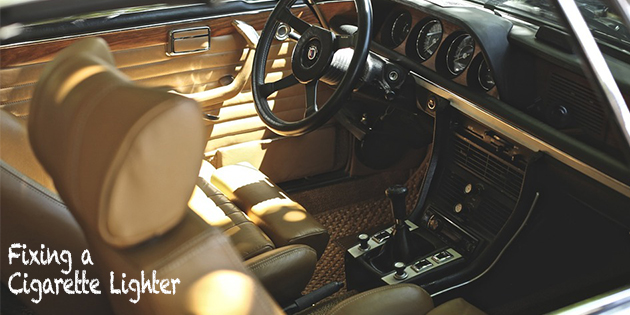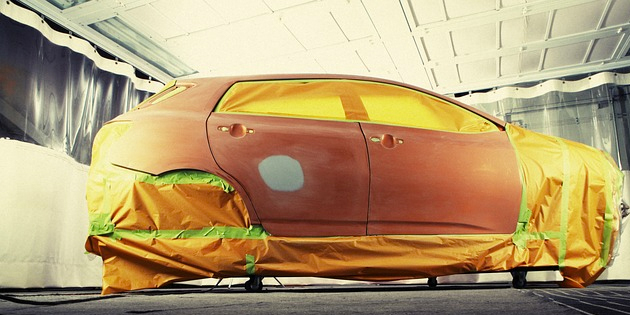About the only time any car owner should have to repair rust spots is during the restoration of an old car. However, we don’t live in an ideal world, and many of us, especially those of us who live in coastal areas, are fighting a running battle with rust on our cars. But then again, we don’t have to allow our cars to rust away right from under us, and there is plenty we can do to fight back.
Fixing rust on cars is not for everyone, but it is not an overly complicated affair, and most people with average skills can repair their own cars for a fraction of the prices body shops charge. Here is how to fix the rust spots on your car…
Time required:
Several days, depending on the severity of the rust to be repaired.
Difficulty level:
Moderately difficult to extremely challenging, depending on the severity and location of the rust, and your level of skill in repairing rust spots on cars.
Special precautions:
- Avoid the use of power tools to sand down cars, since the sheet metal on cars is very thin, and you could end up sanding or grinding right through the metal.
- Don’t smoke when working with paints and solvents. You could set the car (and yourself) on fire when you light up.
- Make sure the solvents, primers, and paints you use are compatible.
- Do not repair rust on load bearing parts of the car with body filler and/or fibreglass. The continual deformation and flexing of the body will only loosen the patch. Have these areas repaired professionally by having steel patches welded in, or by having the load bearing component(s) replaced.
You will need:
- Grinder with a sanding pad (Optional, but not recommended unless you are skilled in the use of power tools.)
- Sanding block.
- Sheets of 150 grit sandpaper.
- Sheets of Wet-or-Dry 600 grit sandpaper
- Sheets of Wet-or-Dry 1000 grit sandpaper
- Sheets of Wet-or-Dry 1 200 grit sandpaper
- Sheets of Wet-or-Dry 1 400 grit sandpaper
- Body filler and catalyst.
- Paint of the correct color.
- Rust converter, and a small paint brush.
- Solvent that is compatible with the primer and paint you are going to use.
- Clean, lint-free rags.
- Pair of scissors.
- Fibreglass mat, resin, and catalyst.
- Small paint brush.
- Small ball-pein hammer.
- Tin snips.
- Masking paper and masking tape.
- Spray painting equipment if you are experienced enough to paint the repaired area.
- Dust mask.
- Eye protection.
- Disposable rubber gloves to prevent skin irritation on contact with fibreglass resin.
- Plastic bucket with clean water.
Step 1.
The first step is to remove all the rust and flaking paint from the rusted area. If you are going to use a grinder and sanding pad, mask off the entire car with masking paper and tape to prevent dust from settling on the rest of the car. Remember to wear eye protection at all times when you are working with power tools.
If you are not using a grinder, use the sanding block and some 150 grit paper the sand the area down to bare metal. Use progressively finer paper to remove scratches caused by the coarse paper, and use plenty of water as a lubricant to prevent the sand paper from clogging up.
Step 2.
During this step you must be careful not to sand over too much of the existing, healthy paint but at the same time, you need to feather in the edges of the healthy paint to eliminate sharp drop-off-points between the healthy paint and the area under repair. Sand the area down until there is no detectable “ridge” between the existing paint and the area under repair. Use your finger tip to feel for ridges. Remove all sanding dust with a clean rag and some solvent.
Step 3.
At this point, the entire rusted area should be sanded down to bare metal. If the rust has not perforated the metal, you can fill in the pits with body filler prepared according to the instructions. Apply the filler, and allow at least several hours curing time. If the rust has perforated the metal, proceed to Step 6.
Step 4.
Use some 1000 grit paper and water to sand down the body filler to the level of the surrounding paint. Chances are that there may still be some small imperfections in the filled-in area, so if there are, apply more body filler, allow to cure, and sand the area down again until the entire surface is perfectly smooth.
NOTE: Use 1000 grit paper only to remove high peaks in the body filler, and use progressively finer paper until the whole are is perfectly smooth, free of visible scratches, and follows the contours of the body exactly.
Step 5.
If you are experienced in using spray painting equipment, you can now mask off the area, and apply the primer. However, if you are not comfortable with the idea of spray painting the area, we recommend that you don’t use this opportunity to learn the process, since mistakes at this point could potentially cost hundreds, if not thousands of dollars to repair or put right.
Instead, take the car to a reputable body shop, and have the area painted professionally. It will now cost much less, since you have done most of the work already.
Step 6.
Rust perforations are a little more difficult to repair, but assuming that the area is sanded down at this point, you need to do the following:
- The edges of the perforation will most likely be ragged, so use the tin snips to cut off as much of the ragged edge as you can.
- Use the ball-pein hammer to knock the inner edges of the perforation down to below the level of the surrounding area. You need to be below this level to make room for the fibreglass mat.
- Treat all visible rust with a generous coating of rust converter. You will know it works if the converter changes color upon contact with the rust. Allow to dry.
Step 7.
Use the scissors to cut a piece of fibreglass mat that will cover the hole, but will remain within the area that is below the surrounding level. Make sure the fibreglass mat extends to at least ¾ of an inch over the perforation.
NOTE: If the perforation is bigger than about two inches, you need to support the fibreglass mat with something to prevent it sagging through the hole. However, the perforation is not always accessible from the other side, but if it is, clean off the area around the hole, and stick a piece of thin cardboard over the hole from the inside. This will form a support structure for the fibreglass mat when you apply it from the outside.
Step 8.
Mix some fibreglass resin, and apply a thin layer of it over the edges of the perforation, then lay the previously cut piece of mat over the hole. Use the brush to “stipple” more resin onto the edges of the mat to saturate the fibres with resin.
NOTE: If the fibreglass mat is not supported in the perforation, resist the temptation to apply resin to the entire piece of mat at this point. If you do, you will dislodge it from around the edges, so wait for thirty minutes or so for the resin around the edges to partially cure. This will hold down the mat, which will make it easier to apply the resin to the whole patch later.
Step 9.
When the resin on the edges of the patch has cured somewhat, use a new brush to apply a THIN coating of new resin to the entire patch. Wait for this layer to cure before doing anything else.
Step 10.
The first layer of resin will take some hours to cure, but once it has, you will have a firm surface to which you can apply a second layer of fibreglass mat. Apply a layer of new resin, place the second layer of the patch in position, and use the brush to saturate the entire with resin, but avoid applying so much resin that it starts forming runs. Fully cured fibreglass resin is exceeding difficult to sand down, so use just enough resin to stick the patch down. Leave the patch to cure for at least 12 hours.
Step 11.
You should now have a solid patch over the perforation, that is below the level of the surrounding body work. Check this by running the sanding block over the patch, and sand down the areas that protrude over the surrounding area.
Step 12.
Clean the repaired area with some solvent to remove all dust, and fill in the area with body filler to slightly above the surrounding level. Leave the body filler to cure for at least 12 hours.
Step 13.
Sand the body filer down until it is perfectly smooth, free of scratches, and follows the body contours exactly. This may take several hours, and you may have to repair small imperfections by applying more body filler, sanding that down, checking for imperfections, applying more filler, etc, etc, etc.
However long it takes, when you are done with this step, you should have an area that apart from the color difference, is indistinguishable from the surrounding body work in terms of surface finish and contour.
Step 14.
If you are going to paint the area, clean off all the dust from the car, and apply the primer and paint. If you are not going to paint the area yourself, follow the advice given in Step 5, and have the patched area painted professionally.
Enjoy learning how to fix rust spots on a car?
Please do us a big favor by sharing this article on social media. It helps us a lot!





No Comments